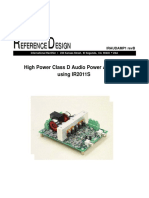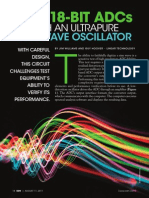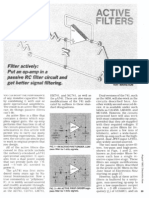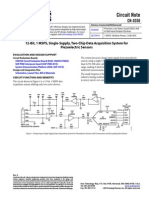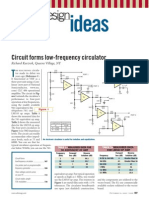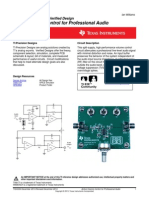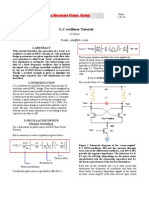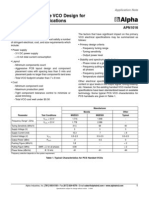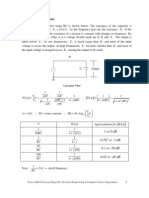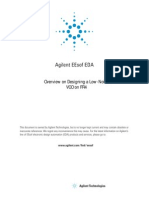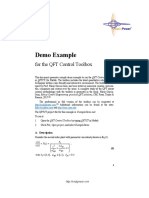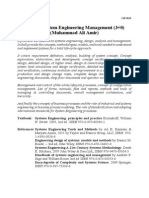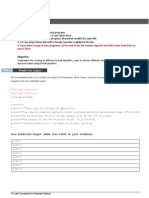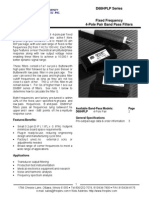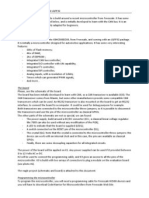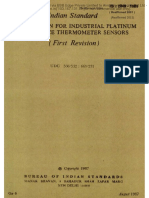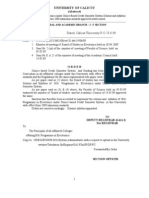Band-Pass Filtered, Inverting - 40 DB Attenuator, 10 HZ - 100 KHZ, 0.1 DB Error
Band-Pass Filtered, Inverting - 40 DB Attenuator, 10 HZ - 100 KHZ, 0.1 DB Error
Uploaded by
Salman ZafarCopyright:
Available Formats
Band-Pass Filtered, Inverting - 40 DB Attenuator, 10 HZ - 100 KHZ, 0.1 DB Error
Band-Pass Filtered, Inverting - 40 DB Attenuator, 10 HZ - 100 KHZ, 0.1 DB Error
Uploaded by
Salman ZafarOriginal Title
Copyright
Available Formats
Share this document
Did you find this document useful?
Is this content inappropriate?
Copyright:
Available Formats
Band-Pass Filtered, Inverting - 40 DB Attenuator, 10 HZ - 100 KHZ, 0.1 DB Error
Band-Pass Filtered, Inverting - 40 DB Attenuator, 10 HZ - 100 KHZ, 0.1 DB Error
Uploaded by
Salman ZafarCopyright:
Available Formats
Collin Wells, Ting Ye
TI Precision Designs: Verified Design
Band-Pass Filtered, Inverting -40 dB Attenuator,
10 Hz 100 kHz, 0.1 dB Error
TI Precision Designs
Circuit Description
TI Precision Designs are analog solutions created by
TIs analog experts. Verified Designs offer the theory,
component selection, simulation, complete PCB
schematic & layout, bill of materials, and measured
performance of useful circuits. Circuit modifications
that help to meet alternate design goals are also
discussed.
An attenuator circuit is required when the magnitude
of an input signal needs to be reduced. This version
of an inverting attenuator features an easily tunable
band-pass filter that is useful to limit noise and also
allows for independent control of the dc output level.
The circuit can be used in a variety of applications
from low-level signal generation to large input signal
attenuation.
Design Resources
Design Archive
TINA-TI
OPA1611
C1
Ask The Analog Experts
WEBENCH Design Center
TI Precision Designs Library
All Design files
SPICE Simulator
Product Folder
R2
R1
C2
VIN
R4
+
VCM
VOUT
C9
An IMPORTANT NOTICE at the end of this TI reference design addresses authorized use, intellectual property matters and
other important disclaimers and information.
TINA-TI is a trademark of Texas Instruments
WEBENCH is a registered trademark of Texas Instruments
SLAU518-June 2013-Revised June 2013
0.1dB Error, -40dB Band-Pass Filtered Attenuator
Copyright 2013, Texas Instruments Incorporated
www.ti.com
Design Summary
The design requirements are as follows:
Supply Voltage: +/-15 V
Input: 100 mVpp to 50 Vpp
Output: -40 dB
The design goals and performance are summarized in Table 1. Figure 1 depicts the ac transfer function of
the design measured from 1 Hz to 10 MHz.
Table 1. Comparison of Design Goals, Simulated, and Measured Performance
Goals
Simulated
Measured
Offset (mV)
0.0623
0.11388
10 Hz Gain Error (dB)
0.5
0.122
0.11
1 kHz Gain Error (dB)
0.1
0.0061
0.01
100 KHz Gain Error (dB)
0.5
0.5876
0.05
Output Noise 10 MHz (Vrms)
2.327
3.521
Quiescent Current (mA)
3.797
3.844
-20
-30
-40
Gain (dB)
-50
-60
Frequency
10 Hz
1 kHz
100 kHz
-70
-80
Gain
-40.11 dB
-39.99 dB
-40.05 dB
VOUT
-90
-100
-110
-120
1.E+00
1.E+01
1.E+02
1.E+03
1.E+04
1.E+05
1.E+06
1.E+07
Frequency (Hz)
Figure 1: Measured ac transfer function
0.1dB Error, -40dB Band-Pass Filtered Attenuator
Copyright 2013, Texas Instruments Incorporated
SLAU518-June 2013-Revised June 2013
www.ti.com
Theory of Operation
A more complete schematic for this design is shown in Figure 2 and the full transfer function is shown in
Equation 1. Although the full transfer function looks daunting, the circuit can be broken down into a few
easy to design subsections. The circuit is based on a standard inverting amplifier and the ratio of the input
resistor, R1, and the feedback resistor, R2, set the pass-band attenuation. The combination of R1 and the
st
input capacitor, C1, create the 1 order high-pass filter and R2, C2, the output resistor, R4, and the output
nd
capacitor, C9, make up the 2 order low-pass filter. R5 and C10 are used to provide decoupling of the VCM
signal and to ensure that the non-inverting input of the amplifier does not float if the reference voltage,
VCM, is not connected. R3 is used to terminate a 50 input signal and can be removed if not desired. The
values of R3, R5, and C10 do not affect the transfer function of this design.
C1
VIN
R1
1 uF 100 k
R3
49.9
R2 1 k
C2
1200 pF
R4
+
VCM
C10
0.1uF
8.2
R5
1 k
VOUT
C9
68 nF
Figure 2: Circuit schematic
VOUT
R 2 C1 s
VCM
VlN
1 R1C1 R 2 C 2 R 4 C 2 s R1R 2 C1 R1R 4 C1 R 2R 4 C 9 s 2 R1R 2R 4 C1C 2 C 9 s 3
(1)
In the following sections, a brief circuit stability overview will be provided and then the circuit will be divided
nd
st
into two sub-circuits that allow for easier design of the pass-band gain, 2 order low-pass filter, and 1
order high-pass filter.
2.1
Circuit Stability
A full stability analysis is outside the scope of this document and can be reviewed using the first reference
is Section 9. However, the two design requirements that must be met to keep this design stable will be
explained. The first requirement is that the output resistor, R4, must be large enough to effectively cancel
the interaction of the output capacitor, C9, and internal op amp output impedance (not shown). This can
be determined in SPICE by setting the amplifier as a non-inverting buffer driving the output resistor in
series with the output capacitor. Then, input a 25 mV 100 mV step to the input and observe the
overshoot and ringing on the output of the amplifier. Continue to increase the series output resistor until a
stable response with less than 25% overshoot is achieved which correlates to roughly 45 of phase
margin. In this design it was determined that an 8.2 series resistor properly compensated capacitive
loads up to 100 nF and will therefore be used for the value of R4 in this design.
The second requirement is that once the output capacitor and resistor have been chosen, the design must
ensure that the low-pass filter formed by R4 and C9, LPFPOLE1, is greater than the frequency of the lowpass filter formed by R2, R4, and C9, LPFPOLE2, by at least two times. This will ensure there is not any
undesired gain peaking or rapid phase shifts in the feedback path which could lead to instability.
SLAU518-June 2013-Revised June 2013
0.1dB Error, -40dB Band-Pass Filtered Attenuator
Copyright 2013, Texas Instruments Incorporated
www.ti.com
2.2
Pass-Band Gain and Low-Pass Filter Design Theory
nd
To simplify the design of the pass-band gain and the 2 order low-pass filter, it will be assumed that C1
acts as a short (0 ) for frequencies above the high-pass filter frequency of 10 Hz. Figure 3 displays the
resulting circuit after shorting C1 while leaving the other components populated.
C1
R3
49.9
VIN
R1
R2
100 k
C2
1 k
1200 pF
R4
+
VCM
C10
0.1uF
8.2
R5
1 k
VOUT
C9
68 nF
Figure 3: Simplified attenuator circuit with C1 shorted
Equation 2 shows the s-domain transfer function of the circuit in Figure 3. The equation shows there is an
inverting gain set by R1 and R2, and two poles that are set by the relationship between R2, R4, C2, and C9.
VOUT
R2
VlN
R1 1 R 2 R 4 C 2 s R 2 R 4 C 4 C9 s 2
2.2.1
(2)
Pass-Band Gain
The inverting gain that will be present in the pass-band of the final transfer function is defined in Equation
3.
GainPASS-BAND
R2
R1
(3)
To set the pass-band gain to -40 dB (0.01 V/V), R2 must be 100 times smaller than R1. The input resistor,
R1, will set the ac input resistance and also will be a contributor to the final noise of the circuit. Setting it to
100 k will allow for proper noise performance and will allow for the calculation of the other values in the
circuit.
R2
2.2.2
nd
R1
GainPASSBAND
100 k
1k
100 V/V
(4)
Order Low-Pass Filter
This design is supposed to operate with a relatively flat response over the frequency range of 10 Hz to 100
kHz. Therefore, the low-pass cutoff frequency must be set greater than 100 kHz to ensure a flat response
up to 100 kHz. The cutoff frequencies will therefore be set greater than 150 kHz.
The design of the 2
nd
order low-pass filter can be simplified using Equations 5 and 6.
LPFPOLE1
1
2 R 4 C9
0.1dB Error, -40dB Band-Pass Filtered Attenuator
Copyright 2013, Texas Instruments Incorporated
(5)
SLAU518-June 2013-Revised June 2013
www.ti.com
LPFPOLE2
1
2 R 2 R 4 C 2
(6)
R4 is in series with the output of the amplifier and should be kept small to prevent large voltage drops from
forming across it if the circuit needs to deliver current to a load. The R2 feedback path will compensate for
any voltage drop across R4 but only as long as the op amp can increase its output voltage high enough to
compensate for the drop which is limited by the supply voltage and the output swing-to-rail performance of
the op amp. Also, as further described in Section 2.1, the value of R4 must properly compensate the
capacitive load presented by C9. Based on analysis also further described in Section 2.1, R4 will be
selected to be 8.2 , allowing for the calculation of C9.
As described further in Section 2.1, the frequency of LPFPOLE2 must be less than the frequency of
LPFPOLE1, preferably by at least two times, to ensure proper stability of the circuit. Therefore to enable
LPFPOLE2 to be set to 150 kHz, LPFPOLE1 will be set to 300 kHz.
C9
1
1
64.7 nF
2 R 4 LPFPOLE1 2 8.2 300 kHz
(7)
Based on the calculation, a standard value for C9 of 68 nF was selected.
Setting LPFPOLE2 to 150 kHz enables the calculation of C2.
C2
1
1
1052pF
2 R 2 R 4 LPFPOLE2 2 1008.2 150 kHz
(8)
A larger standard value of 1200 pF was chosen for C2 over a smaller value to ensure the stability of the
design was maintained.
2.3
1st Order High-Pass Filter
st
To simplify the design of the pass-band gain and the 1 order high-pass filter, it will be assumed that C2
and C4 act as open circuits (>1 G) for frequencies below the low-pass filter frequency of 100 kHz.
Figure 4 displays the resulting circuit after opening C 2 and C9 while leaving the other components
populated.
C1
R1
R2 1 k
1 uF 100 k
R3
49.9
VIN
C2
R4
+
VCM
C10
0.1uF
8.2
R5
1 k
VOUT
C9
Figure 4: Attenuator circuit with C2 and C9 open
The s-domain transfer function for this part of the circuit is shown in Equation 9. The equation shows that
there will be a zero at the origin (s = 0) and then a pole to flatten the response at the pass-band gain
st
forming the 1 order high-pass filter.
SLAU518-June 2013-Revised June 2013
0.1dB Error, -40dB Band-Pass Filtered Attenuator
Copyright 2013, Texas Instruments Incorporated
www.ti.com
VOUT
R 2 C1 s
VlN
1 R1 C1 s
(9)
The pole that defines the high-pass filter cutoff frequency, HPFPOLE1, is shown in Equation 10.
HPFPOLE1
1
2 R1 C1
(10)
To ensure little attenuation at 10 Hz, set the high-pass filter cutoff frequency below 2.5 Hz by choosing C1.
C1
1
1
0.636 uF
2 R1 HPFPOLE1 2 100 k 2.5 Hz
(11)
Choosing a standard value of 1 uF for C1 pushes the high-pass cutoff frequency a little lower helping to
further reduce attenuation at 10 Hz.
Component Selection
3.1
Operational Amplifier
Since this is primarily an ac application, the op amp used in this design should have low noise, low totalharmonic-distortion (THD), high slew-rate, wide bandwidths, high open-loop gain (AOL). A rail-to-rail
output stage is desirable to allow for lower supply voltage operation while maintaining good output swing
capabilities.
The OPA1611 high-performance bipolar input audio op amp has only 1.1nV/Hz input noise and
0.00015% THD at 1 kHz, 27V/us slew rate, 40 MHz bandwidth, and 130 dB of AOL making it an excellent
choice for a high performance version of this circuit.
Other amplifier options for this application include the chopper-stabilized OPA211, OPA134, or OPA234 as
further discussed in Section 7.
3.2
Passive Component Selection
The most critical passive components to meet the 0.1 dB gain error specification for this design are the
resistors that set the pass-band gain, R1 and R2. These resistors were chosen to be 0.1% tolerance to
ensure good gain accuracy without calibration. Resistors R1 and R4 and capacitors C2 and C9 were
selected for the lowest tolerances reasonably available 1% and 5% respectively. If tighter accuracy of the
AC frequency points is desired, use lower tolerance devices for these components as well.
Any capacitors in the signal path should be sized for a voltage coefficient that well exceeds the voltage
that will be placed across them to ensure that the values dont change in circuit during normal operation.
To keep the signal distortion to a minimum, use C0G/NP0 dielectric capacitors when possible. When
C0G/NP0 capacitors are not available due to the need for higher capacitance values or voltage ratings
choose X7R dielectrics.
The tolerance of the other passive components in this design may be selected for 1% or greater because
they will not directly affect the pass-band transfer function of this design.
0.1dB Error, -40dB Band-Pass Filtered Attenuator
Copyright 2013, Texas Instruments Incorporated
SLAU518-June 2013-Revised June 2013
www.ti.com
Simulation
TM
The TINA-TI schematic shown in Figure 5 includes the circuit values obtained in the design process. A
dc offset voltage of 62.6 V and dc quiescent current of 3.797 mA were reported by the simulation.
C1 1u
R2 1k
R1 100k
C2 1.2n
R3 49.9
4.1
TM
VOUT 62.604uV
V+
C9 68n
Iq 3.797mA
C11 100p
VCM 0
V-
Figure 5: TINA-TI
C12 100n
C8 100n
C7 10u
C10 100n
V- 15
R4 8.2
U1 OPA1612
R5 1k
V+ 15
C4 100n
C3 10u
V+
C5 100p
V-
C6 100n
VIN
simulation schematic showing dc output offset and quiescent current
AC Transfer Function
The ac transfer function results of the circuit, shown in Figure 6, show the proper pass-band gain and filter
frequencies based on the component values calculated in Section 2.
T
-20.00
Gain (dB)
-40.00
-60.00
10 Hz: -40.110 dB
1 kHz: -40.0000 dB
100 kHz: -40.497 dB
-80.00
-100.00
1
10
100
1k
10k
Frequency (Hz)
100k
1M
10M
Figure 6: Simulated Full-Scale Transfer Function
SLAU518-June 2013-Revised June 2013
0.1dB Error, -40dB Band-Pass Filtered Attenuator
Copyright 2013, Texas Instruments Incorporated
www.ti.com
A 100-sweep Monte-Carlo simulation was run with the component tolerances specified in Section 3 to
produce more realistic results. Figure 7 shows a zoomed-in version of the ac transfer function allowing the
deviation between the Monte-Carlo cases to be viewed easier.
T -39.00
Gain (dB)
-39.50
-40.00
-40.50
-41.00
1
10
100
1k
Frequency (Hz)
10k
100k
1M
Figure 7: Simulated Monte-Carlo Full-Scale Transfer Function
The numerical results of the Monte-Carlo simulation are displayed in Table 2. To determine the total gain
error in dB at a given frequency, take the standard deviation and multiply it by three times (3-) to cover
roughly 99.7% of the units. The 3- value can then be added to the difference of the average results from
the ideal gain of -40 dB to determine a realistic gain error that a population of built units would show.
GainError(dB) 3 GainIDEAL (3 0.00195) 39.9998 40 0.0061
(9)
Table 2: Monte-Carlo DC Transfer Results
Min
Max
Average ()
Std. Dev. ()
Gain at 10 Hz (dB)
-40.1183
-40.097
-40.1083
0.00458
0.122
Gain at 1 kHz (dB)
-40.0043
-39.9952
-39.9998
0.00195
0.0061
Gain at 100 kHz (dB)
-40.5583
-40.4388
-40.4959
0.03055
0.5876
0.1dB Error, -40dB Band-Pass Filtered Attenuator
Copyright 2013, Texas Instruments Incorporated
3- Gain Error
SLAU518-June 2013-Revised June 2013
www.ti.com
4.2
Transient Response
The transient response of the design with a 100 mVpp, 1 kHz sine-wave input signal is shown in Figure 8.
As expected, the output is 1 mVpp with the small dc offset reported in Table 1. This test case is an
example of a useful application of this circuit for attenuating the outputs of function generators which
commonly have minimum output amplitudes of 100 mVpp.
50.00m
VIN
0.00
-50.00m
563.28u
VOUT 63.39u
-436.51u
0
Figure 8: TINA-TI
TM
1m
2m
3m
Time (s)
4m
5m
- Low-level signal generation with 100 mVpp input and 1 mVpp output
25.00
VIN
0.00
-25.00
250.08m
VOUT
0.00
-249.17m
0
Figure 9: TINA-TI
TM
1m
2m
3m
Time (s)
4m
5m
- Large signal attenuation with 50 Vpp input and 500 mVpp output
SLAU518-June 2013-Revised June 2013
0.1dB Error, -40dB Band-Pass Filtered Attenuator
Copyright 2013, Texas Instruments Incorporated
www.ti.com
4.3
Step Response
The small-signal stability of the system was verified by shorting VIN to GND and applying a step response
to the non-inverting input of the op amp that caused the output to change by roughly 100 mV. The results
are shown in Figure 10.
T
125.00m
Voltage (V)
100.00m
75.00m
50.00m
25.00m
0.00
0.00
25.00u
TM
Figure 10: TINA-TI
4.4
50.00u
Time (s)
75.00u
100.00u
- Small-Signal Step Response Simulation
Noise Testing
The total noise of the circuit was simulated from 1 Hz to 10 MHz. The results, shown in Figure 11 display
the noise bandwidth of the circuit to be roughly 450 kHz.
Total noise (V)
2.32u
1 kHz: 150.9 nV
10 kHz: 463.1 nV
100 kHz: 1.444 uV
1 MHz: 2.229 uV
10 MHz: 2.327 uV
1.16u
0.00
1
10
100
TM
Figure 11: TINA-TI
10
1k
10k
Frequency (Hz)
100k
1M
10M
- Total output noise from 1 Hz to 10 MHz
0.1dB Error, -40dB Band-Pass Filtered Attenuator
Copyright 2013, Texas Instruments Incorporated
SLAU518-June 2013-Revised June 2013
www.ti.com
4.5
Simulated Result Summary
The simulation results are compared against the design goals in Table 3.
Table 3: Simulated Result Summary
Goals
Simulated
Offset (mV)
0.0623
10 Hz Gain Error (dB)
0.5
0.122
1 kHz Gain Error (dB)
0.1
0.0061
100 KHz Gain Error (dB)
0.5
0.5876
Output Noise 10 MHz (Vrms)
2.327
Quiescent Current (mA)
3.797
PCB Design
The PCB schematic and bill of materials can be found in Appendix A.1 and A.2.
5.1
PCB Layout
For optimal performance in this design follow standard precision PCB layout guidelines including: using
ground planes, proper power supply decoupling, keeping the summing node as small as possible, and
using short thick traces for sensitive nodes. The layout for the design is shown in Figure 12.
Figure 12: Altium PCB Layout
SLAU518-June 2013-Revised June 2013
0.1dB Error, -40dB Band-Pass Filtered Attenuator
Copyright 2013, Texas Instruments Incorporated
11
www.ti.com
Verification and Measured Performance
6.1
AC Transfer Function
AC transfer function data was collected using a gain phase analyzer that swept the input signal from 1 Hz
10 MHz while measuring the output signal. The results are displayed in Figure 13 and Table 5.
-20
-30
-40
Gain (dB)
-50
-60
Gain @ 10 Hz = -40.11 dB
Gain @ 1 kHz = -39.99 dB
Gain @ 100 kHz = -40.05 dB
-70
VOUT
-80
-90
-100
-110
-120
1.E+00
1.E+01
1.E+02
1.E+03
1.E+04
1.E+05
1.E+06
1.E+07
Frequency (Hz)
Figure 13: Measured ac transfer function
Table 4: Measured ac result summary
Measured
6.2
10 Hz Gain Error (dB)
0.11
1 kHz Gain Error (dB)
0.01
100 KHz Gain Error (dB)
0.05
DC Measurements
DC measurements were made for the offset voltage and the quiescent current for five units. The average
values are reported in Table 5 below.
Table 5: Measured dc result summary
Measured
12
Output Offset Voltage
(mV)
0.11388
Quiescent Current (mA)
3.844
0.1dB Error, -40dB Band-Pass Filtered Attenuator
Copyright 2013, Texas Instruments Incorporated
SLAU518-June 2013-Revised June 2013
www.ti.com
6.3
6.3.1
Transient Measurements
Small Signal Generation
Testing a high-gain input stage requires a low-level test signal source to prevent the input stage from
saturating. This circuit is useful for attenuating the outputs of common function generators to create these
low-level test signals. Figure 14 displays the generation of a 1 mVpp output signal from a 100 mVpp input
signal.
Figure 14: Measured transient response with 100 mVpp input and 1 mVpp output
6.4
Large Signal Attenuation
The topology used for this design accommodates input signals that are above the supply rails applied to
the op amp. This is demonstrated in Figure 15 where a 50 Vpp input signal is applied when only +/-15 V
(30 Vpp) supplies were used to power the op amp. The circuit can tolerate higher voltages but extreme
caution should be used when testing with voltages above 50 V.
Figure 15: Measured transient response with 50 Vpp input and 500 mVpp output
SLAU518-June 2013-Revised June 2013
0.1dB Error, -40dB Band-Pass Filtered Attenuator
Copyright 2013, Texas Instruments Incorporated
13
www.ti.com
6.5
Small-Signal Stability
The small-signal response is indicative of the stability of a circuit design. An unstable design presents
unwanted overshoot, ringing, and long settling times. Figure 16 displays the output of the attenuator circuit
when a 100 mV step input (Channel 1) is applied to the non-inverting input of the circuit. The output
Channel 2) quickly settles to the input level with almost no overshoot or ringing indicating a stable design.
Figure 16: Measured small signal step response for stability analysis
6.6
Output FFT
The FFT was taken from 20 Hz to 100 kHz to view the output spectrum of the circuit with a 1 Vrms 1 kHz
input signal. The output spectrum shows the expected -40 dB output at 1 kHz and the rest of the
frequency spectrum is very clean with a low noise floor.
Figure 17: Measured FFT with 1 kHz 1 Vrms input and 1 Vrms reference
14
0.1dB Error, -40dB Band-Pass Filtered Attenuator
Copyright 2013, Texas Instruments Incorporated
SLAU518-June 2013-Revised June 2013
www.ti.com
6.7
Output Noise
The output noise of this attenuator was measured to a 10 MHz bandwidth using a 101 V/V, low-noise,
band-pass filtered gain stage to increase the noise output of the attenuator circuit to a level measurable by
common lab equipment. For more information on op amp circuit noise and the calculation, simulation, and
TM
measurement of noise see the second reference in Section 9. A TINA-TI representation of the 101 V/V
filtered gain stage is shown in Figure 18. The output of the attenuator circuit is high-pass filtered by CG1
and RG1, then gained by 101 V/V by U2, RG2, and RG3, and then lastly is low-pass filtered at 10 MHz by RG4
and CG2.
CG5 10u
V1 5
V- 15
V-
C5 100p
C6 100n
NOISE_ATTENUATOR
R4 8.2
C9 68n
C11 100p
C12 100n
CG3 100n
NOISE_TOTAL
CG1 100u
V+
U1 OPA1612
R5 1k
VEE
VCC
V2 5
V-
RG1 220
R3 49.9
CG6 10u
R2 1k
R1 100k
C2 1.2n
C10 100n
C4 100n
C1 1u
C8 100n
V+ 15
C3 10u
VCC
C7 10u
V+
DIS
RG4 100
U2 OPA847
CG4 100n
CG2 160p
VEE
RG2 220
TM
Figure 18: TINA-TI
RG3 22k
Attenuator circuit noise measurement test configuration
The output noise of the circuit shown in Figure 18 (NoiseTOTAL) is measured and then the output noise of
the attenuator circuit (NoiseATTENUATOR) is calculated by first vector subtracting the calibrated output noise
of both the filtered gain circuit (NoiseGAINSTAGE) and the measurement instrument (NoiseSCOPE) yielding the
gained attenuator noise (NoiseATTENUATOR_GAIN). The final attenuator circuit noise can then be obtained by
dividing by the 101 V/V gain of the filtered gain circuit. A final conversion into VRMS may or may not be
required depending on the output of the instrument. An example of these calculations is shown for the
oscilloscope measurements in the following equations:
NoiseSCOPE 0.26 mVpp
(12)
NoiseGAINSTAGE 5.6 mVpp
(13)
NoiseTOTAL 6 mVpp
(14)
NoiseATTENUATOR_GAIN NoiseTOTAL NoiseGAINSTAGE NoiseSCOPE 2.138 mVpp
2
NoiseATTENUATOR
NoiseATTEND_GAIN
NoiseATTENUATOR( VRMS )
SLAU518-June 2013-Revised June 2013
101V/V
21.17 Vpp
NoiseATTENUATOR
3.529 Vrms
6
0.1dB Error, -40dB Band-Pass Filtered Attenuator
Copyright 2013, Texas Instruments Incorporated
(15)
(16)
(17)
15
www.ti.com
The output noise was measured using a few different instruments to ensure correlation between
measurement methods. Measurements made with the spectrum analyzer were converted from a spectral
density (nV/Hz) to Vrms based on the bandwidth of the measurement (BW) and the correction factor
st
(Kn) based on the order of the filter used. For a 1 order low-pass filter, Kn is equal to 1.57.
NoiseVRMS NoisenV/
Hz
BW * 1.57
(18)
Table 6: Measured Noise Result Summary
10 MHz BW
6.8
Spectrum Analyzer (Vrms)
3.521
Oscilloscope (Vrms)
3.529
Measured Result Summary
The measured results are compared against the design goals in Table 7.
Table 7: Measured Result Summary
Goals
Simulated
Measured
Offset (mV)
0.0623
0.11388
10 Hz Gain Error (dB)
0.5
0.122
0.11
1 kHz Gain Error (dB)
0.1
0.0061
0.01
100 KHz Gain Error (dB)
0.5
0.5876
0.05
Output Noise 10 MHz (Vrms)
2.327
3.521
Quiescent Current (mA)
3.797
3.844
Modifications
Almost any amplifier can perform this application but certain amplifiers are better for high performance
designs. High performance versions of this circuit will benefit from an amplifier with low-noise, low THD,
high AOL, wide bandwidths, and high supply voltages. Other +36 V amplifiers for this application are the
OPA627, OPA827, OPA211, OPA140, OPA134. Single-supply versions of this circuit could be created
with the OPA320, OPA350, OPA365, or OPA376 devices.
Table 8: Alternate +36V Amplifiers
Amplifier
Max Offset
Voltage (V)
Noise at 1 kHz
(nV/Hz)
THD at 1 kHz
(%)
AOL (dB)
Bandwidth
(MHz)
Quiescent
Current (mA)
OPA1611
500
1.1
0.000015
130
40
3.6
OPA134
0.00008
120
OPA140
120
5.1
0.00005
126
11
1.8
OPA211
50
1.1
0.000015
130
45
3.6
OPA627
100
5.2
0.00003
120
16
OPA827
150
0.00004
126
22
4.8
Table 9: Alternate Op Amps
16
Amplifier
Max Offset
Voltage (V)
Noise
THD
AOL
Bandwidth
(MHz)
Quiescent
Current (mA)
OPA320
150
8.5
0.0005
130
20
1.6
OPA350
500
17
0.0006
122
38
5.2
OPA376
25
7.5
0.00027
134
5.5
0.76
OPA365
200
12
0.0004
120
50
4.6
0.1dB Error, -40dB Band-Pass Filtered Attenuator
Copyright 2013, Texas Instruments Incorporated
SLAU518-June 2013-Revised June 2013
www.ti.com
About the Authors
Collin Wells is an applications engineer in the Precision Linear group at Texas Instruments where he
supports industrial products and applications. Collin received his BSEE from the University of Texas,
Dallas.
Ting Ye is a field application engineer based in Taipei who supports industrial and precision customers.
She performed a six month rotation working with the Precision Linear group where she supported op amp
and current loop products for industrial applications.
Acknowledgements & References
1.
Green, Tim, Operational Amplifier Stability Parts 1-11, November 2008, Available: http://www.engenius.net/site/zones/acquisitionZONE/technical_notes/acqt_050712
2.
Kay, A., Operational Amplifier Noise, Newnes, 2012
SLAU518-June 2013-Revised June 2013
0.1dB Error, -40dB Band-Pass Filtered Attenuator
Copyright 2013, Texas Instruments Incorporated
17
www.ti.com
Appendix A.
A.1 Electrical Schematic
The Altium electrical schematic for this design can be seen in Figure A.1.
Figure A-1: Electrical Schematic
18
0.1dB Error, -40dB Band-Pass Filtered Attenuator
Copyright 2013, Texas Instruments Incorporated
SLAU518-June 2013-Revised June 2013
www.ti.com
A.2 Bill of Materials
The bill of materials for this circuit can be seen in Figure A.2.
Figure A-2: Bill of Materials
SLAU518-June 2013-Revised June 2013
0.1dB Error, -40dB Band-Pass Filtered Attenuator
Copyright 2013, Texas Instruments Incorporated
19
IMPORTANT NOTICE FOR TI REFERENCE DESIGNS
Texas Instruments Incorporated ("TI") reference designs are solely intended to assist designers (Buyers) who are developing systems that
incorporate TI semiconductor products (also referred to herein as components). Buyer understands and agrees that Buyer remains
responsible for using its independent analysis, evaluation and judgment in designing Buyers systems and products.
TI reference designs have been created using standard laboratory conditions and engineering practices. TI has not conducted any
testing other than that specifically described in the published documentation for a particular reference design. TI may make
corrections, enhancements, improvements and other changes to its reference designs.
Buyers are authorized to use TI reference designs with the TI component(s) identified in each particular reference design and to modify the
reference design in the development of their end products. HOWEVER, NO OTHER LICENSE, EXPRESS OR IMPLIED, BY ESTOPPEL
OR OTHERWISE TO ANY OTHER TI INTELLECTUAL PROPERTY RIGHT, AND NO LICENSE TO ANY THIRD PARTY TECHNOLOGY
OR INTELLECTUAL PROPERTY RIGHT, IS GRANTED HEREIN, including but not limited to any patent right, copyright, mask work right,
or other intellectual property right relating to any combination, machine, or process in which TI components or services are used.
Information published by TI regarding third-party products or services does not constitute a license to use such products or services, or a
warranty or endorsement thereof. Use of such information may require a license from a third party under the patents or other intellectual
property of the third party, or a license from TI under the patents or other intellectual property of TI.
TI REFERENCE DESIGNS ARE PROVIDED "AS IS". TI MAKES NO WARRANTIES OR REPRESENTATIONS WITH REGARD TO THE
REFERENCE DESIGNS OR USE OF THE REFERENCE DESIGNS, EXPRESS, IMPLIED OR STATUTORY, INCLUDING ACCURACY OR
COMPLETENESS. TI DISCLAIMS ANY WARRANTY OF TITLE AND ANY IMPLIED WARRANTIES OF MERCHANTABILITY, FITNESS
FOR A PARTICULAR PURPOSE, QUIET ENJOYMENT, QUIET POSSESSION, AND NON-INFRINGEMENT OF ANY THIRD PARTY
INTELLECTUAL PROPERTY RIGHTS WITH REGARD TO TI REFERENCE DESIGNS OR USE THEREOF. TI SHALL NOT BE LIABLE
FOR AND SHALL NOT DEFEND OR INDEMNIFY BUYERS AGAINST ANY THIRD PARTY INFRINGEMENT CLAIM THAT RELATES TO
OR IS BASED ON A COMBINATION OF COMPONENTS PROVIDED IN A TI REFERENCE DESIGN. IN NO EVENT SHALL TI BE
LIABLE FOR ANY ACTUAL, SPECIAL, INCIDENTAL, CONSEQUENTIAL OR INDIRECT DAMAGES, HOWEVER CAUSED, ON ANY
THEORY OF LIABILITY AND WHETHER OR NOT TI HAS BEEN ADVISED OF THE POSSIBILITY OF SUCH DAMAGES, ARISING IN
ANY WAY OUT OF TI REFERENCE DESIGNS OR BUYERS USE OF TI REFERENCE DESIGNS.
TI reserves the right to make corrections, enhancements, improvements and other changes to its semiconductor products and services per
JESD46, latest issue, and to discontinue any product or service per JESD48, latest issue. Buyers should obtain the latest relevant
information before placing orders and should verify that such information is current and complete. All semiconductor products are sold
subject to TIs terms and conditions of sale supplied at the time of order acknowledgment.
TI warrants performance of its components to the specifications applicable at the time of sale, in accordance with the warranty in TIs terms
and conditions of sale of semiconductor products. Testing and other quality control techniques for TI components are used to the extent TI
deems necessary to support this warranty. Except where mandated by applicable law, testing of all parameters of each component is not
necessarily performed.
TI assumes no liability for applications assistance or the design of Buyers products. Buyers are responsible for their products and
applications using TI components. To minimize the risks associated with Buyers products and applications, Buyers should provide
adequate design and operating safeguards.
Reproduction of significant portions of TI information in TI data books, data sheets or reference designs is permissible only if reproduction is
without alteration and is accompanied by all associated warranties, conditions, limitations, and notices. TI is not responsible or liable for
such altered documentation. Information of third parties may be subject to additional restrictions.
Buyer acknowledges and agrees that it is solely responsible for compliance with all legal, regulatory and safety-related requirements
concerning its products, and any use of TI components in its applications, notwithstanding any applications-related information or support
that may be provided by TI. Buyer represents and agrees that it has all the necessary expertise to create and implement safeguards that
anticipate dangerous failures, monitor failures and their consequences, lessen the likelihood of dangerous failures and take appropriate
remedial actions. Buyer will fully indemnify TI and its representatives against any damages arising out of the use of any TI components in
Buyers safety-critical applications.
In some cases, TI components may be promoted specifically to facilitate safety-related applications. With such components, TIs goal is to
help enable customers to design and create their own end-product solutions that meet applicable functional safety standards and
requirements. Nonetheless, such components are subject to these terms.
No TI components are authorized for use in FDA Class III (or similar life-critical medical equipment) unless authorized officers of the parties
have executed an agreement specifically governing such use.
Only those TI components that TI has specifically designated as military grade or enhanced plastic are designed and intended for use in
military/aerospace applications or environments. Buyer acknowledges and agrees that any military or aerospace use of TI components that
have not been so designated is solely at Buyer's risk, and Buyer is solely responsible for compliance with all legal and regulatory
requirements in connection with such use.
TI has specifically designated certain components as meeting ISO/TS16949 requirements, mainly for automotive use. In any case of use of
non-designated products, TI will not be responsible for any failure to meet ISO/TS16949.
Mailing Address: Texas Instruments, Post Office Box 655303, Dallas, Texas 75265
Copyright 2013, Texas Instruments Incorporated
You might also like
- Designing Loop AntennasDocument18 pagesDesigning Loop AntennasCesar AvilaNo ratings yet
- NON-TOD Bill Preview PDFDocument1 pageNON-TOD Bill Preview PDFAkash Singh0% (1)
- Sine Wave GeneratorDocument12 pagesSine Wave GeneratorSorina LupuNo ratings yet
- A Complete Narrow-Band Power Line Communication Node For AMRDocument6 pagesA Complete Narrow-Band Power Line Communication Node For AMRSudheer KakaniNo ratings yet
- Precision Full-Wave Rectifier, Dual-Supply: TI Precision Designs: Verified DesignDocument24 pagesPrecision Full-Wave Rectifier, Dual-Supply: TI Precision Designs: Verified DesignkumargpalaniNo ratings yet
- Iraudamp1 PDFDocument22 pagesIraudamp1 PDFamijoski6051No ratings yet
- 26070-Test 18 Bit ADCs With An Ultrapure Sine Wave Oscillator PDFDocument5 pages26070-Test 18 Bit ADCs With An Ultrapure Sine Wave Oscillator PDFLuca CarboneNo ratings yet
- Unconventional Phase-Locked Loops Simplify Difficult DesignsDocument18 pagesUnconventional Phase-Locked Loops Simplify Difficult DesignsAndrew JonesNo ratings yet
- Design: IdeasDocument5 pagesDesign: Ideasdcastrelos2000No ratings yet
- A 100MHz To 500MHz Low Noise Feedback Amplifier Using ATF-54143 (AN5057 Avago)Document8 pagesA 100MHz To 500MHz Low Noise Feedback Amplifier Using ATF-54143 (AN5057 Avago)XollloXNo ratings yet
- Atf36077 Appl2Document4 pagesAtf36077 Appl2Johnny TienNo ratings yet
- Iraudamp 1Document22 pagesIraudamp 1luizcpimentaNo ratings yet
- All Pass Filter DesignDocument2 pagesAll Pass Filter Designnivia25No ratings yet
- TV Modulator Circuit: Semiconductor Technical DataDocument10 pagesTV Modulator Circuit: Semiconductor Technical Databanduat83No ratings yet
- DeDocument7 pagesDeSudhakar SpartanNo ratings yet
- Active FiltersDocument5 pagesActive Filtersver_ekNo ratings yet
- DiDocument5 pagesDiTao Quang BinhNo ratings yet
- CN0350Document7 pagesCN0350Narayan ApteNo ratings yet
- DiDocument6 pagesDipani256No ratings yet
- Transformer-Coupled Front-End For Wideband A/D Converters: Primary SecondaryDocument4 pagesTransformer-Coupled Front-End For Wideband A/D Converters: Primary SecondaryAvinash SharmaNo ratings yet
- A Low-Power 60-GHz CMOS Transceiver For WiGig Applications PDFDocument2 pagesA Low-Power 60-GHz CMOS Transceiver For WiGig Applications PDFdanial_1234No ratings yet
- Adf PLL Adf4159 Ad8065 Opamp CN0302Document5 pagesAdf PLL Adf4159 Ad8065 Opamp CN0302ibanitescuNo ratings yet
- EDN Design Ideas 2006Document142 pagesEDN Design Ideas 2006chag1956100% (1)
- Iraudamp1 - High Power Class D Audio Power Amplifier Using IR2011SDocument24 pagesIraudamp1 - High Power Class D Audio Power Amplifier Using IR2011SChuYurNo ratings yet
- Proyecto. CrossoverDocument15 pagesProyecto. CrossoverAppa D. LuffyNo ratings yet
- A Simple Regen Radio For Beginner NotesDocument3 pagesA Simple Regen Radio For Beginner NotesMR X100% (1)
- Switched Capacitor Band-Pass Filter 0.1 Object: C 3 DB BPDocument16 pagesSwitched Capacitor Band-Pass Filter 0.1 Object: C 3 DB BPmohamedNo ratings yet
- A 6-b 1-GS/s 30-mW ADC in 90-nm CMOS Technology: Yuan-Ching Lien and Jri Lee National Taiwan University, Taipei, TaiwanDocument4 pagesA 6-b 1-GS/s 30-mW ADC in 90-nm CMOS Technology: Yuan-Ching Lien and Jri Lee National Taiwan University, Taipei, TaiwanSunil PandeyNo ratings yet
- Digital To Analog Converter: Raghu Tumati May 11, 2006Document30 pagesDigital To Analog Converter: Raghu Tumati May 11, 2006সাদ ইবনে মাজNo ratings yet
- Sboa034 FOTODIODO TBRIDGEDocument8 pagesSboa034 FOTODIODO TBRIDGEJoanzarzalNo ratings yet
- Second Stage Filter DesignDocument6 pagesSecond Stage Filter DesignNnamdiNo ratings yet
- Simple FSKDocument6 pagesSimple FSKFaten AliNo ratings yet
- An 1037Document4 pagesAn 1037kuazuNo ratings yet
- An 1162Document36 pagesAn 1162naniknanikNo ratings yet
- Circuit Note: High Performance, 12-Bit, 500 MSPS Wideband Receiver With Antialiasing FilterDocument6 pagesCircuit Note: High Performance, 12-Bit, 500 MSPS Wideband Receiver With Antialiasing Filtersanjay_drdo237No ratings yet
- Application Note 101 July 2005 Minimizing Switching Regulator Residue in Linear Regulator OutputsDocument12 pagesApplication Note 101 July 2005 Minimizing Switching Regulator Residue in Linear Regulator OutputsPravin MevadaNo ratings yet
- Active Volume Control For Professional AudioDocument25 pagesActive Volume Control For Professional AudioTrinhNguyentranNo ratings yet
- 28.2 A 0.29mm2 Frequency Synthesizer in 40nm CMOS With 0.19psrms Jitter and lt-100dBc Reference Spur For 802.11acDocument3 pages28.2 A 0.29mm2 Frequency Synthesizer in 40nm CMOS With 0.19psrms Jitter and lt-100dBc Reference Spur For 802.11acMitchell LeeNo ratings yet
- 300w tp9383 PDFDocument3 pages300w tp9383 PDFlu1agp100% (1)
- Paradise Datacom Mini-Redundant SSPA 209495 RevADocument8 pagesParadise Datacom Mini-Redundant SSPA 209495 RevAarzeszutNo ratings yet
- L.C Oscillator Tutorial: 1 AbstractDocument18 pagesL.C Oscillator Tutorial: 1 AbstractChi PhamNo ratings yet
- High Power Class D Audio Power Amplifier Using IR2011SDocument22 pagesHigh Power Class D Audio Power Amplifier Using IR2011SAbubakar SidikNo ratings yet
- Compensation Method Peak Current Mode Control Buck AN028 enDocument13 pagesCompensation Method Peak Current Mode Control Buck AN028 ensadqazwsxNo ratings yet
- 06616415Document5 pages06616415jitu_4No ratings yet
- VCO Colpits SimulationDocument12 pagesVCO Colpits SimulationAmarok81No ratings yet
- Applied Sciences: Fully Di Current-Feedback Instrumentation Amplifier With R-2R Dac O Bridge SensorsDocument9 pagesApplied Sciences: Fully Di Current-Feedback Instrumentation Amplifier With R-2R Dac O Bridge Sensorspraba821No ratings yet
- Application Note An-1052: Using The Ir217X Linear Current Sensing IcsDocument7 pagesApplication Note An-1052: Using The Ir217X Linear Current Sensing IcsLullaby summerNo ratings yet
- Active and Passive FiltersDocument11 pagesActive and Passive FiltersHemanshu DasNo ratings yet
- Agilent Eesof Eda: Overview On Designing A Low-Noise Vco On Fr4Document6 pagesAgilent Eesof Eda: Overview On Designing A Low-Noise Vco On Fr4bayman66No ratings yet
- SA612Document13 pagesSA612radioscribdNo ratings yet
- Ultra-Low Power Phase-Locked LoopDocument4 pagesUltra-Low Power Phase-Locked Loophawking1122No ratings yet
- 13 Optimizing Universal Radio ICsDocument11 pages13 Optimizing Universal Radio ICswebdrifter100% (1)
- Implementation of Second Order Switched Capacitors Filters With Feedback SignalDocument3 pagesImplementation of Second Order Switched Capacitors Filters With Feedback SignalInternational Journal of Application or Innovation in Engineering & ManagementNo ratings yet
- 1-2ghz VcoDocument7 pages1-2ghz VcomorenodrixNo ratings yet
- Reference Guide To Useful Electronic Circuits And Circuit Design Techniques - Part 2From EverandReference Guide To Useful Electronic Circuits And Circuit Design Techniques - Part 2No ratings yet
- Reference Guide To Useful Electronic Circuits And Circuit Design Techniques - Part 1From EverandReference Guide To Useful Electronic Circuits And Circuit Design Techniques - Part 1Rating: 2.5 out of 5 stars2.5/5 (3)
- Modeling of FaultDocument53 pagesModeling of FaultSalman ZafarNo ratings yet
- 32 IJTPE Issue18 Vol6 No1 Mar2014 pp204 209Document6 pages32 IJTPE Issue18 Vol6 No1 Mar2014 pp204 209Salman ZafarNo ratings yet
- 6Wxg/Rq6Hohfwlrqri6) &/ V, Pshgdqfhiru 3Urwhfwlrq&Rruglqdwlrqzlwk2Yhufxuuhqw5Hod/ Lqd'Lvwulexwlrq6/VwhpDocument4 pages6Wxg/Rq6Hohfwlrqri6) &/ V, Pshgdqfhiru 3Urwhfwlrq&Rruglqdwlrqzlwk2Yhufxuuhqw5Hod/ Lqd'Lvwulexwlrq6/VwhpSalman ZafarNo ratings yet
- QFTCT DemoExample DescriptionDocument13 pagesQFTCT DemoExample DescriptionSalman ZafarNo ratings yet
- A Protection Coordination Index For Evaluating Distributed Generation Impacts On Protection For Meshed Distribution SystemsDocument10 pagesA Protection Coordination Index For Evaluating Distributed Generation Impacts On Protection For Meshed Distribution SystemsSalman ZafarNo ratings yet
- EE 300: System Engineering Management (3+0) (Muhammad Ali Amir)Document1 pageEE 300: System Engineering Management (3+0) (Muhammad Ali Amir)Salman ZafarNo ratings yet
- G3 Lab2 Nov13 2015Document8 pagesG3 Lab2 Nov13 2015Salman ZafarNo ratings yet
- Radiation Interaction and Detection: Alpha & Beta DecayDocument6 pagesRadiation Interaction and Detection: Alpha & Beta DecaySalman ZafarNo ratings yet
- 100 HZ To 100 KHZ Band Pass Filter: D68Hplp SeriesDocument6 pages100 HZ To 100 KHZ Band Pass Filter: D68Hplp SeriesSalman ZafarNo ratings yet
- Differntial ProtectionDocument81 pagesDifferntial ProtectionSalman Zafar100% (1)
- Basslink T: Powered Subwoofer System Service ManualDocument27 pagesBasslink T: Powered Subwoofer System Service Manualatomo333No ratings yet
- D D D D D D D D: LF353 Jfet-Input Dual Operational AmplifierDocument7 pagesD D D D D D D D: LF353 Jfet-Input Dual Operational AmplifierJessica moreno orjuelaNo ratings yet
- Electrical Installation For 1th Floor QDocument2 pagesElectrical Installation For 1th Floor QWelday GebremichaelNo ratings yet
- 012 PRC Tacr PDFDocument474 pages012 PRC Tacr PDFbacuoc.nguyen356No ratings yet
- Stary and Eddy CalculationDocument4 pagesStary and Eddy Calculationishwer kushwahNo ratings yet
- MELSEC iQ-R Digital-Analog Converter Module User's Manual (Startup)Document68 pagesMELSEC iQ-R Digital-Analog Converter Module User's Manual (Startup)Hoàng NguyễnNo ratings yet
- Evaluation Board s08dz60Document2 pagesEvaluation Board s08dz60Warren O LeddaNo ratings yet
- Panel PT KseDocument3 pagesPanel PT KseaurinkokelloNo ratings yet
- MIG Welding Speed SelectionDocument1 pageMIG Welding Speed SelectionbudakgemukNo ratings yet
- Tvss PreciosDocument5 pagesTvss PreciosMiguel Angel Miranda UgarteNo ratings yet
- Packard Bell Easynote M3 Disassembly ManualDocument20 pagesPackard Bell Easynote M3 Disassembly Manualg321m46No ratings yet
- Power Transformers Principles and ApplicationDocument286 pagesPower Transformers Principles and ApplicationJuan Carlos Plazarte100% (1)
- ZFV Ds e 1 1 csm1717Document5 pagesZFV Ds e 1 1 csm1717way5858No ratings yet
- DPA001 - ATX-Dedicated PWM Controller DPA001: Customer Specific Device From ON SemiconductorDocument18 pagesDPA001 - ATX-Dedicated PWM Controller DPA001: Customer Specific Device From ON Semiconductorsontuyet82No ratings yet
- IS 2848 - Specition For PRT SensorDocument25 pagesIS 2848 - Specition For PRT SensorDiptee PatingeNo ratings yet
- Previous Report No.3: "Complementary Symmetry Amplifier": Universidad Nacional de IngenieríaDocument8 pagesPrevious Report No.3: "Complementary Symmetry Amplifier": Universidad Nacional de IngenieríaAlessandro VillegasNo ratings yet
- Summer Training Report On Unnao Sub Station PDFDocument59 pagesSummer Training Report On Unnao Sub Station PDFAnubhav SachanNo ratings yet
- MR - Rashitha CIN-267Document9 pagesMR - Rashitha CIN-267ashenjayawardana37No ratings yet
- Ingersoll-Rand X Series Compressor 80443864 2008 Dec Instruction ManualDocument116 pagesIngersoll-Rand X Series Compressor 80443864 2008 Dec Instruction ManualCykhong KhongNo ratings yet
- BSCelectronicsDocument120 pagesBSCelectronicskirthika143No ratings yet
- AP Physics C - 2021 HW 12 Potential & CapacitanceDocument3 pagesAP Physics C - 2021 HW 12 Potential & CapacitanceRegina LinNo ratings yet
- 4 SR 6Document1 page4 SR 6itp.agmNo ratings yet
- Electricity (Grid and Distribution Codes) GN. No. 451 (Contd.)Document83 pagesElectricity (Grid and Distribution Codes) GN. No. 451 (Contd.)IulianNo ratings yet
- 5 Ac Coupling and Small Signal AnalysisDocument13 pages5 Ac Coupling and Small Signal AnalysisDeepika Rani SonaNo ratings yet
- Physics Investigatory Project (Electronic Eye Security System)Document3 pagesPhysics Investigatory Project (Electronic Eye Security System)nabiha khanNo ratings yet
- Chapter 1.1-EE042-3-2-IES-DC GeneratorDocument65 pagesChapter 1.1-EE042-3-2-IES-DC Generatortanaya.s.gadkariNo ratings yet
- Raizer 2017Document7 pagesRaizer 2017MaksimBarannikNo ratings yet
- Xii Physics Experiment 2Document3 pagesXii Physics Experiment 2Solomon Peter SunilNo ratings yet
- Cu NLNG Siwes Report MainDocument51 pagesCu NLNG Siwes Report MainT-Rex EdidorkNo ratings yet





